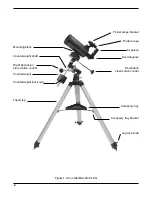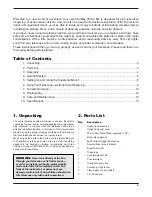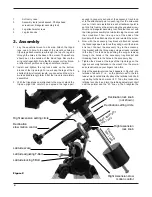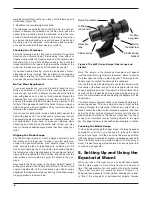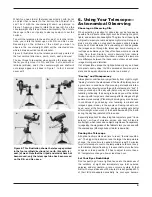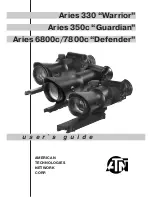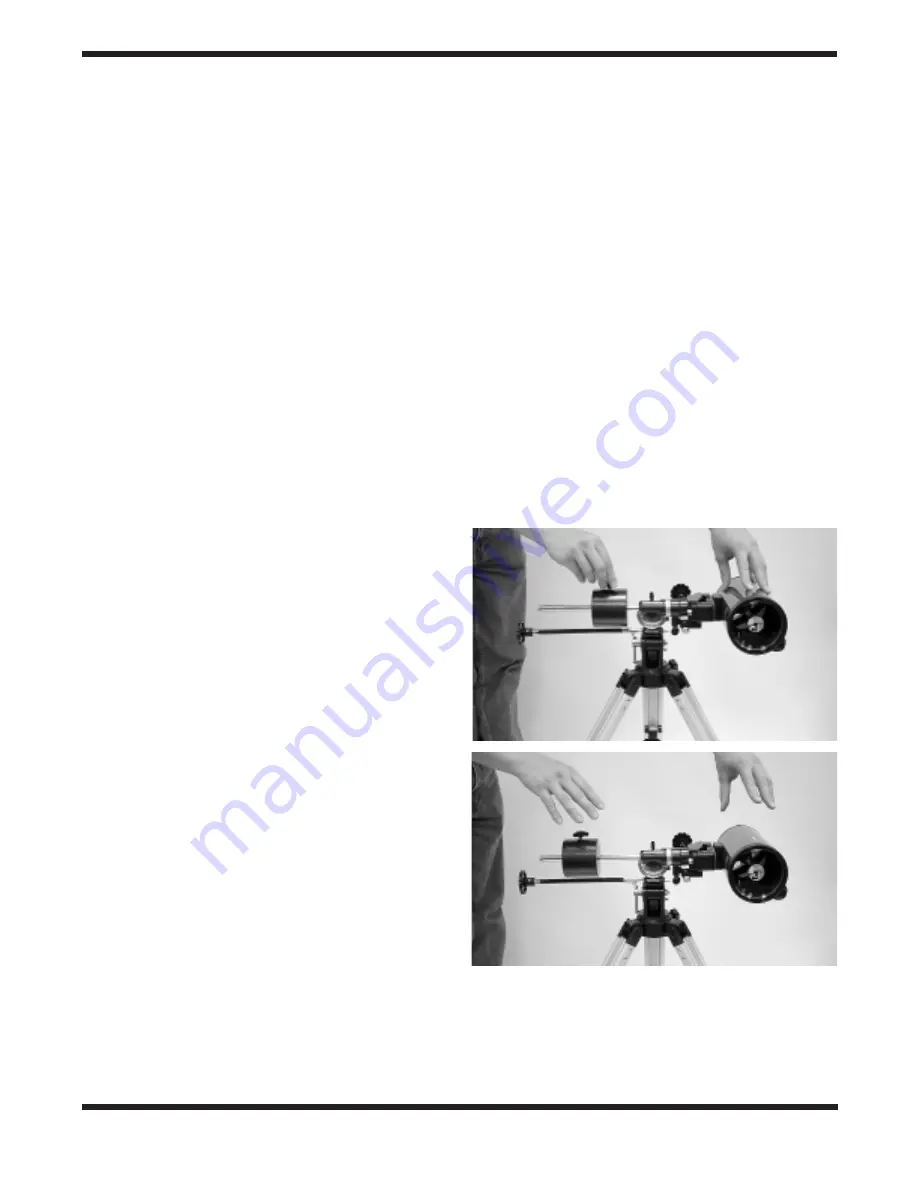
5
latitude lock t-bolt. The declination (Dec.) and right ascen-
sion (R.A.) axes may need re-positioning (rotation) as
well. Be sure to loosen the R.A. and Dec. lock knobs
before doing this. Retighten the R.A. and Dec. lock knobs
once the equatorial mount is properly oriented.
7.
Thread the counterweight shaft into the equatorial mount
at the base of the declination axis until tight.
8.
Remove the screw and washer on the bottom of the coun-
terweight shaft and slide the counterweight onto the
shaft. Make sure the counterweight lock knobs are ade-
quately loosened to allow the counterweight shaft to pass
through the hole. Position the counterweight about
halfway up the shaft and tighten the lock knobs. Replace
the screw and washer on the counterweight shaft.
9.
Attach the 1/4"-20 adapter to the top of the equatorial
mount using the bolts and washers that come with the
adapter. Push the bolts, with washers attached, up
through the holes in the top of the mount and thread them
into the bottom of the adapter. Tighten the bolts securely
with the supplied wrench.
10. Connect the optical tube assembly to the 1/4"-20 adapter
on the mount by threading the adapter’s shaft into the
hole in the optical tube’s mounting block. Orient the opti-
cal tube so that it is parallel to the length of the adapter,
as it is in Figure 1. Tighten this connection firmly by rotat-
ing the knurled thumb wheel on the adapter
counter-clockwise.
11. Now attach the two slow-motion cables to the R.A. and
Dec. slow-motion shafts of the equatorial mount by posi-
tioning the thumbscrew on the end of the cable over the
indented slot on the shaft, then tightening the thumb
screw. A cable can be attached to either end of the R.A.
shaft, whichever is most convenient for you. Use the
shorter cable for the R.A. shaft.
12. To place the finder scope in its bracket, first remove the
O-ring from the finder scope bracket. Loosen the three
nylon thumbscrews on the bracket until the tips of the
screws are flush with the inside of the bracket. Insert the
objective end (the end without the rubber eyeguard) of
the finder scope into the bracket ring with the three nylon
thumbscrews. When the finder scope is through the sec-
ond ring of the bracket and as far as it will go, push the
O-Ring on the objective end of the finder scope and set it
about 1" down the finder scope tube. Then pull the finder
scope back gently until the O-Ring seats itself on the
ridge inside the second ring of the finder scope bracket.
Tighten the three nylon screws equally until they are
touching the sides of the finder scope.
13. Insert the base of the finder scope bracket into the dove-
tail holder on the optical tube. Lock the bracket into
position by tightening the knurled thumbscrew on the
dovetail holder.
14. Remove the cap from the eyepiece adapter on the rear of
the optical tube and insert the chrome barrel of the mirror
star diagonal. Secure the diagonal with the thumbscrews
on the eyepiece adapter.
15. Now, insert the chrome barrel of the 25mm eyepiece into
the star diagonal. Secure the eyepiece with the thumb-
screws on the star diagonal.
The telescope system is now fully assembled. Keep the dust
cover over the front end of the telescope when it is not in use.
It is also a good idea to cover the eyepiece; use the cover cap
that came with it.
4. Getting Started
Balancing the Telescope
To insure smooth movement of the telescope on both axes of
motion (R.A. and Dec.) of the equatorial mount, it is impera-
tive that the optical tube be properly balanced.
1. Keeping one hand on the telescope optical tube, loosen the
R.A. lock knob. Make sure the Dec. lock knob is locked. The
telescope should now be able to rotate freely about the R.A.
axis. Rotate it until the counterweight shaft is parallel to the
ground (i.e., horizontal).
2. Now loosen the counterweight lock knob and slide the
weight along the shaft until it exactly counterbalances the tel-
escope (Figure 3a). That’s the point at which the shaft
Figure 3: Proper operation of the equatorial mount
requires balancing the telescope tube on the R.A. axis.
(a) With the R.A. lock knob released, slide the
counterweight along the counterweight shaft until it
just counterbalances the tube. (b) When you let go with
both hands, the tube should not drift up or down.
a.
b.


